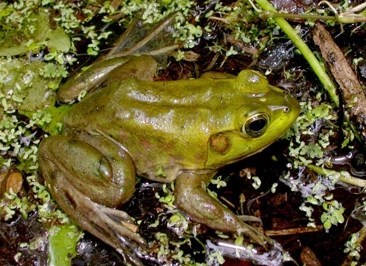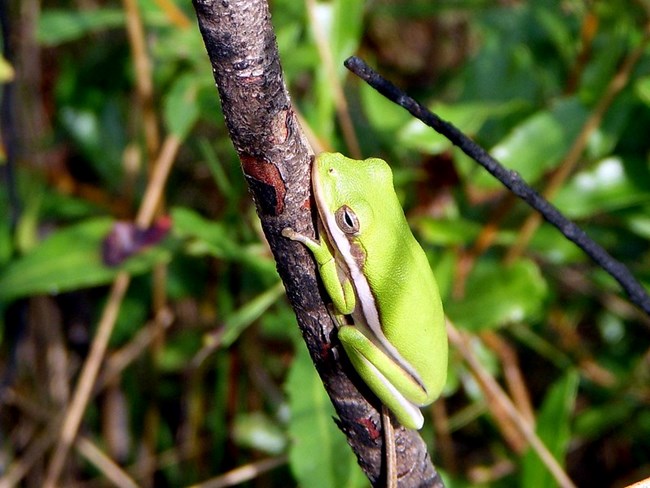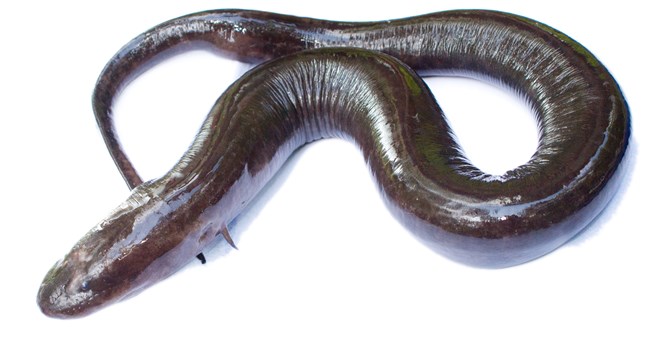|
Big Cypress National Preserve is home to 18 species of amphibian. Click here to view our Amphibian Checklist, or continue reading to learn about some of the species you might see (or hear!) as you explore. 
USGS / J. Willson Appearance: Pig Frogs have green to brown backs with dark, irregular spots. A net-like pattern crosses their light-colored bellies. Other distinguishing characteristics include hind feet with webbing nearly to the tips of the toes and a narrow, pointed head. Their tympanum, or outer ear, appears as a circle behind their eye and is larger in males than females. Size: The second largest frog in Florida, Pig Frogs are usually 3-5 inches in length, although they have been found as large as 6.5 inches. Habitat: Pig Frogs live in permanent bodies of water such as ponds, sloughs, cypress domes, wet prairies, and canals. They are occasionally found on land at night or in wet weather. Diet: Pig Frogs feed on crayfish, aquatic invertebrates, and insects such as dragonflies and beetles. They will occasionally eat fish and other amphibians. Reproduction: Breeding occurs from April to August, and is accompanied by their breeding call, which sounds like the grunting of a pig. The female will lay as many as 10,000 eggs in a surface film, often over vegetation. The eggs hatch after only a few days. 
Appearance: Green Treefrogs are smooth-skinned and range in color from gray-green to dark green to bright green, sometimes with yellow flecks. They usually have a light-colored stripe bordered in black running down each side, but in some individuals the stripe does not have a border or is absent. Large, sticky pads for climbing can be found on their toes. Size: 1-2.5 inches in length. Habitat: Green Treefrogs are arboreal, meaning they spend much of their time in trees. They live near permanent bodies of water such as swamps, cypress domes, ponds, lakes, and ditches. Diet: Green Treefrogs feed on flies, mosquitoes, beetles, crickets, and other small insects and invertebrates. Reproduction: Breeding occurs from March to October. The breeding call of the Green Treefrog sounds like a loud quacking noise. The female lays multiple egg clusters, potentially laying over 300 eggs in one night! The egg clusters are often attached to vegetation and will hatch after about five days. 
Brian Gratwicke, CC BY 2.0 <https://creativecommons.org/licenses/by/2.0>, via Wikimedia Commons Appearance: The Two-toed Amphiuma is a large, elongated salamander that is often mistaken for an eel. It is dark gray to brown on top and fades to a lighter gray on its belly. It gets its common name from the two toes that can be found at the end of each of its four tiny legs. Size: At 1.5-3.8 feet long, this is one of the longest salamander species in the U.S. Habitat: Two-toed Amphiumas can be found in freshwater areas such as swamps, ponds, ditches, and slow-moving streams. They are often around areas that are mucky or highly vegetated. Diet: Two-toed Amphiumas hunt in shallow water for fish, frogs, crayfish, and small snakes. Reproduction: In southern Florida, females lay up to 200 eggs in January and February. The eggs are laid under logs and debris, and the female incubates them for 5-6 months by coiling around them. |
Last updated: December 18, 2023
